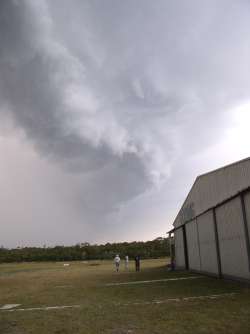Donner und Blitzen!
Lightning Strikes and Sailplanes
Q. … Incidentally, are you aware of any specific results of GRP gliders being struck by lightning? Everyone mentions the English event where the beast became briefly biplanar as the water in the ballast bags superheated and expanded, but I gather that is rare. Presumably it wouldn’t be good for the instruments, but I note that Alice [an LS4] has metal straps to form an electrical continuum in the event of Huey hitting the ‘smite’ key. I gather the average instructor feels that being struck by lightning is an unfortunate event for a glider, but do you know of definite structural problems that have resulted?
Yours seeking enlightenment,
Al.

Subsequently I read a little of the effects of lightning on aeroplanes, and remained convinced for many years that a strike, although frightening and detrimental to avionics, would have no effect on the structure or the occupant/s.
Not so, I later discovered. Firstly, GRP sailplanes (and most others) do not have the little metal strips on the trailing edges of their wings which you will find on GA aircraft. These strips do the same job as the earthstraps you used to see on cars years ago – they dispel static charges. Without them, the bolt will exit through the path of least resistance, often via the aileron and rudder hinges – welding them solid in the process (hence the doodads Gary attached to Alice).*
So you’re belting along near Vne, trying to stay out of the cloud a handspan above the canopy which same is now largely opaque due to the copious quantity of water bucketing down on it, bolts from the blue crackling about your wingtips like The Mariner’s worst nightmare of St Elmo’s Fire, and suddenly the controls freeze. You think about this for a moment. Perhaps three milliseconds.
Kaboom! Struth, that was close. BANG. Glancing to your left, you are presented with an unimpeded if somewhat murky view of the world some 10,000 feet below. This is something of a worry considering that there was a nice shiny white wing there last time you looked.
Fibreglass gelcoat, as it becomes older, will often become porous and admit minute quantities of water into the structure. Lightning superheats this water instantaneously, causing anything from minor delamination to structural failure.
And you’re quite right, it’s very rare. When was the last time you saw some idiot flying in a thunderstorm?
R.
P.S. But there is NOTHING like the buzz of riding a storm front!
*Gary Speight’s LS4, now famous for it’s short-fielder on Lake Keepit.
ASK21 disintegrates after lightning strike, UK, April 1999
“hearing a ‘very loud bang’ and then ‘feeling very draughty’ … slowly becoming aware that ‘something was seriously amiss'”
www.dft.gov.uk/stellent/groups/dft_foi/documents/page/dft_foi_038203.pdf [404]
Ian Bennning of Sunraysia Gliding Club, who sent the ASK21 reference above, also mentioned that “lightning struck our IS28 a few years ago while it was on wire launch, no damage or injuries.”
Graeme Cooper was the passenger in the aircraft who parachuted to safety. He writes a harrowing account of the event here:
http://www.justgiving.com/big40reachfortheskiesagain
He also requests that visitors donate a little to the Parkinson’s Disease Society.
I have recently complied a ‘scrapbook’ of the days events of 1999 that has some photos of the actual wreckage and shots taken during the reconstructions for TV that you may find interesting.
http://…/thebig40reachfortheskiesagain/…attredirects=0
LIGHTNING STALLED AIRCRAFT
http://www.science-frontiers.com/sf091/sf091g15.htm
Further reading: A Stranger to the Ground – Richard Bach.
Tenth anniversary of Dunstable lightening strike on glider.
http://www.dunstabletoday.co.uk:80/dunstable-news/….5152390.jp
One Response to Lightning Strikes
Leave a Reply
You must be logged in to post a comment





Lightning strikes a Copa Airlines (a Continental affiliate) airplane at the gate on May 12, 2011. You’ll need to watch it several times to see all of the action; It’s only about 10 seconds duration. Three key things/areas to watch. first watch the tail of the aircraft as the lightning bolt hits the vertical stabilizer, do not blink, it happens that fast. Next, watch the nose of the aircraft where ground crew walk up to and under the nose of the airplane, then quickly retreat. Then, look just to your left of the nose gear. That brown square on the ground is a metal plate embedded in the concrete, with an access cover in it. The lightning strike exits the airplane onto the metal plate, which sends the access cover flying through the air toward the tug on the far left.